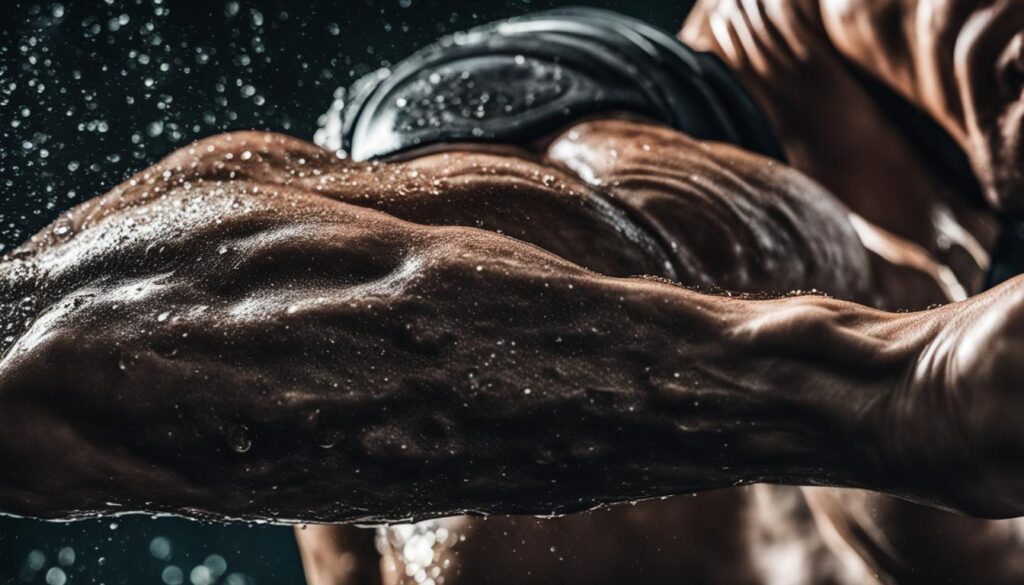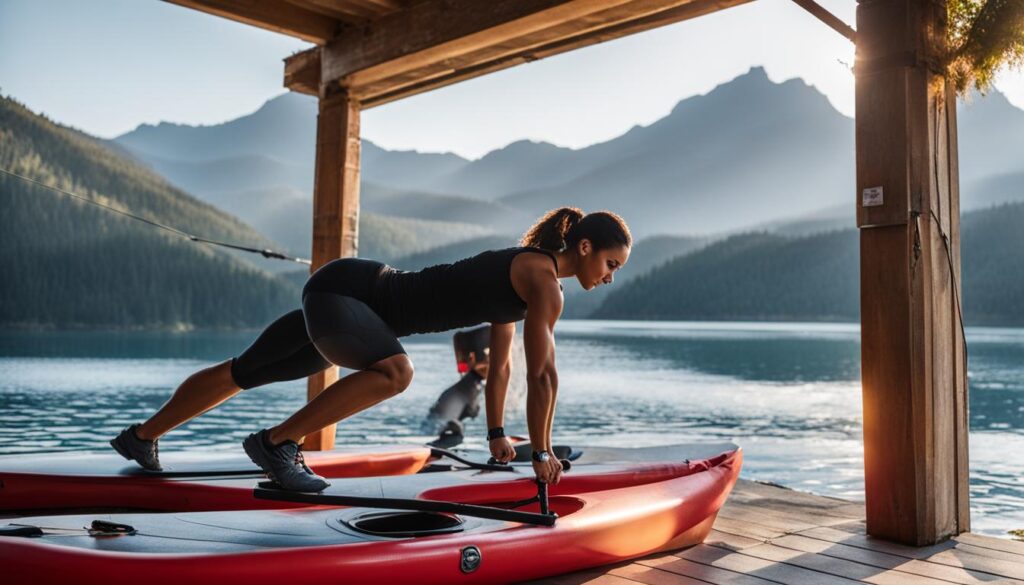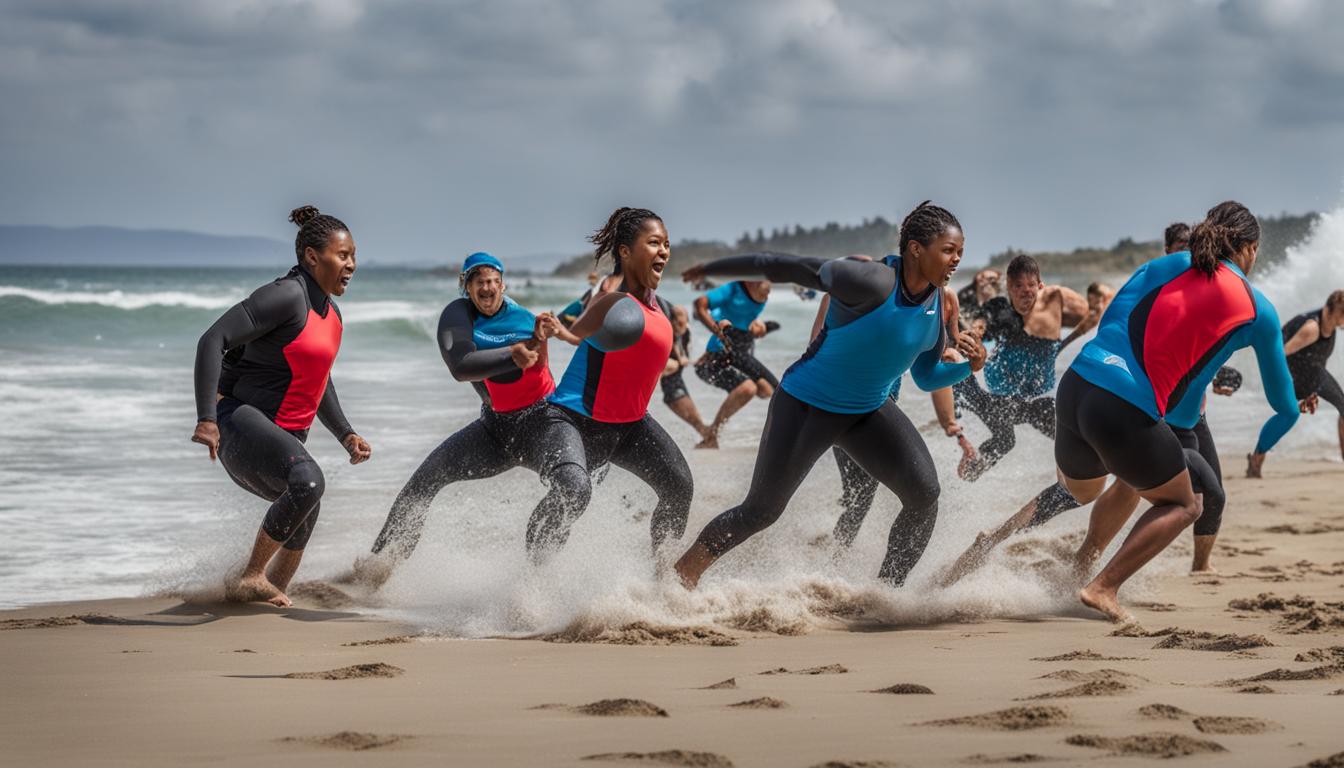Are you a paddler looking to take your performance to the next level? If so, incorporating circuit training into your workout routine can be a game-changer. Circuit training is a form of exercise that combines strength training and cardiovascular conditioning, making it perfect for paddlers who need both muscular strength and endurance on the water.
In this article, we will dive into the world of circuit training specifically tailored for paddlers. Pro kayaker and personal trainer Heather Herbeck has developed an 8-week off-season training plan designed to target the muscles used in paddling, building both strength and endurance. From kettlebell swings to overhead presses, Herbeck’s program will help you elevate your paddling game.
So, get ready to paddle your way to peak performance with these paddler-specific circuit training routines!
Key Takeaways:
- Circuit training combines strength training and cardiovascular conditioning for paddlers.
- Pro kayaker Heather Herbeck has developed an 8-week off-season training plan for enhanced performance.
- The program includes exercises such as kettlebell swings, overhead press, cleans, goblet squats, pull-ups, cable rows, and push-ups.
- Building strength and endurance in the muscles used in paddling is crucial for optimal performance.
- Incorporating flatwater sessions and interval training can further improve paddling endurance.
The Importance of Muscles for Paddling
When it comes to kayaking, having strong muscles is essential for optimal performance. A solid foundation of muscular strength and endurance is crucial for maintaining proper body mechanics, maneuvering through challenging rapids, and tackling long-distance paddling. So, let’s dive in and explore the key muscles that come into play when you’re out on the water.
The muscles used in kayaking can be categorized into different areas of the body. The back muscles, including the lats, rhomboids, trapezius, and erector spinae, provide stability and power during each paddle stroke. The shoulders, comprising the deltoids and teres major, are responsible for generating forward propulsion. The chest muscles, particularly the pectoralis major, aid in the pushing and pulling actions required for effective paddling. The arms and hands, including the biceps, triceps, forearm muscles, and grip muscles, provide the strength and control necessary for gripping the paddle and propelling the kayak forward. The abdominals, specifically the external obliques, help to stabilize the core and maintain proper posture. Lastly, the hip and leg muscles play a crucial role in providing stability and balance while paddling.
To enhance your kayaking performance, it’s important to focus on building strength in these key muscles. This will not only improve your paddling efficiency but also reduce the risk of injuries. So, let’s paddle our way to stronger muscles and a better kayaking experience!

| Muscle Group | Specific Muscles |
|---|---|
| Back | Lats, Rhomboids, Trapezius, Erector Spinae |
| Shoulders | Deltoids, Teres Major |
| Chest | Pectoralis Major |
| Arms and Hands | Biceps, Triceps, Forearm Muscles, Grip Muscles |
| Abdominals | External Obliques |
| Hips and Legs | Various Muscles for Stability |
Strength Training Exercises for Paddlers
To enhance your paddling strength and improve overall performance on the water, incorporating specific strength training exercises into your routine is essential. These exercises target the muscles used in kayaking, helping to build both strength and endurance. Here are some key exercises that can take your paddling to the next level:
Kettlebell Swings
Kettlebell swings are a dynamic exercise that engages your entire body, particularly your posterior chain muscles, including the glutes, hamstrings, and back. Start with a lightweight kettlebell and perform swings in a controlled manner, focusing on a powerful hip hinge movement.
Overhead Press
The overhead press primarily targets your shoulder muscles, including the deltoids and trapezius. This exercise helps to enhance your upper body strength and stability, which is important for maintaining proper paddling technique and maneuvering in challenging waters.
Cleans
Cleans are a compound movement that works multiple muscle groups simultaneously, including the legs, back, shoulders, and arms. This exercise improves overall strength and power, allowing you to generate more force during each paddle stroke.
Goblet Squats
Goblet squats are an effective exercise for developing lower body strength and stability. This exercise targets the quads, hamstrings, glutes, and core muscles, which are all crucial for maintaining balance and power while paddling.
Pull-Ups
Pull-ups are an excellent exercise for building upper body and back strength, targeting muscles such as the latissimus dorsi, rhomboids, and biceps. These muscles are essential for maintaining proper posture and generating power during paddling movements.
Cable Rows
Cable rows are another great exercise for strengthening the back muscles, particularly the rhomboids and trapezius. This exercise improves your paddling posture and helps prevent injuries by reducing the risk of imbalances between the chest and back muscles.
Push-Ups
Push-ups are a classic bodyweight exercise that targets the chest, shoulders, triceps, and core muscles. This exercise builds upper body strength and stability, which is crucial for maintaining control and stability during challenging paddling conditions.
When performing these exercises, it’s important to focus on proper technique and execute slow and controlled movements. Start with lighter weights and gradually increase the resistance as your strength improves. If you’re new to strength training or unsure about proper form, consider working with a certified trainer or coach to ensure safety and maximize the effectiveness of your workouts.

Endurance Training for Paddlers
Endurance training is a crucial component of any paddler’s training routine. It helps to enhance cardiovascular fitness, build stamina, and prepare the body for the demands of long-distance kayaking. Flatwater sessions are an excellent way to improve paddling endurance, allowing you to focus on technique and rhythm while building up your cardiovascular capacity.
During flatwater sessions, you can incorporate various training techniques to optimize your endurance gains. Start with moderate-paced paddling for a specific duration, such as 30 minutes, gradually increasing the duration as your fitness improves. This steady-state training helps to improve your aerobic endurance and prepares your muscles for prolonged paddling sessions.
Interval training is another effective method for boosting paddling endurance. Incorporate intervals of hard paddling, pushing yourself to paddle at a higher intensity for a set distance or time. Follow each hard interval with a recovery period of easy paddling or rest. Repeat this cycle several times during your flatwater session to challenge your cardiovascular system and improve your ability to sustain higher intensities for longer periods.
Sample Flatwater Endurance Training Session:
| Activity | Duration | Intensity |
|---|---|---|
| Warm-up | 10 minutes | Easy pace |
| Moderate-paced paddling | 30 minutes | Moderate intensity |
| Hard paddling intervals | 1 minute | High intensity |
| Recovery | 2 minutes | Easy pace |
| Cool-down | 10 minutes | Easy pace |
Remember to listen to your body during endurance training and gradually increase the intensity and duration of your sessions as you progress. It’s important to find a balance between pushing yourself and allowing enough time for recovery to avoid overtraining and injury. Incorporating endurance training into your overall paddling routine will help you develop the stamina and cardiovascular fitness necessary for extended kayaking adventures.
Conclusion
Circuit training is a game-changer for paddlers looking to enhance their performance on the water. By incorporating a variety of exercises into your training routine, such as kettlebell swings, overhead press, cleans, goblet squats, pull-ups, cable rows, and push-ups, you can target the specific muscles used in kayaking and improve both strength and endurance. These circuit workouts for paddling are designed to push your limits and take your kayaking fitness to new heights.
But it doesn’t stop there. To truly excel in the world of water sports, it’s essential to incorporate flatwater sessions and interval training into your training regimen. These sessions not only improve your paddling endurance but also prepare your body for the demands of long-distance kayaking. By paddling at a moderate pace and incorporating intervals of hard paddling with recovery periods, you can boost your cardiovascular fitness and conquer the waters like never before.
Circuit training offers a comprehensive approach to improving your paddling strength, endurance, and overall fitness. Whether you’re hitting the gym or braving the waves, these workouts will help you make waves in the world of kayaking. So, gear up, get on board, and start shaping up. Your next adventure awaits, and with the right training, you’ll be ready to take on any challenge that comes your way.
FAQ
What muscles are used in kayaking?
The key muscles used in kayaking include the back (lats, rhomboid, trapezius, erector spinae), shoulders (deltoids, teres major), chest (pectoralis major), arms and hands (biceps, triceps, forearm, grip muscles), abdominals (external obliques), and hips/legs (for stability).
What exercises can I do to improve my paddling strength?
To improve paddling strength, you can incorporate exercises such as kettlebell swings, overhead press, cleans, goblet squats, pull-ups, cable rows, and push-ups into your training routine. These exercises target the muscles used in kayaking and help build muscular strength and endurance.
How should I perform these exercises?
It is important to focus on technique, execute slow and controlled movements, and work with a weight that causes fatigue at the end of each set. These exercises should be performed with caution and under the guidance of a certified trainer or coach.
What can I do to improve my paddling endurance?
You can improve paddling endurance by incorporating flatwater sessions into your training routine. This can include paddling at a moderate pace for a certain duration or incorporating intervals of hard paddling with recovery periods. Endurance training should be done in conjunction with strength training for optimal performance.
What is circuit training and why is it beneficial for paddlers?
Circuit training is a method of training that targets the specific muscles used in kayaking and improves both strength and endurance. Incorporating exercises like kettlebell swings, overhead press, cleans, goblet squats, pull-ups, cable rows, and push-ups into your training routine can greatly enhance your performance on the water. Circuit training offers a comprehensive approach to improving paddling strength, endurance, and overall fitness.





